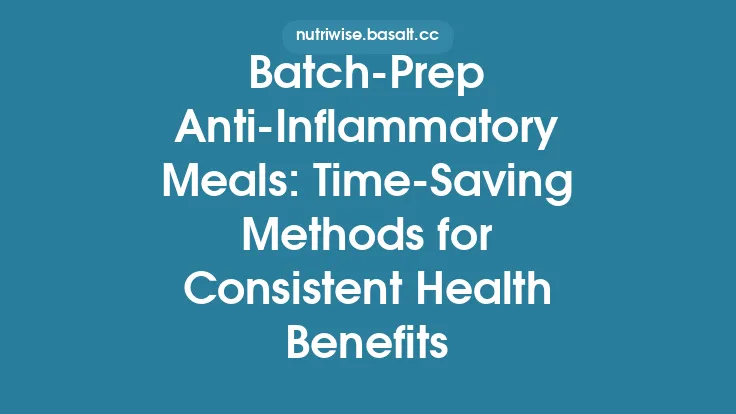Roasting is a beloved cooking method that brings out deep, caramelized flavors while creating a satisfying texture. When applied thoughtfully, roasting can also act as a powerful ally in preserving—and sometimes even enhancing—anti‑inflammatory phytochemicals such as polyphenols, flavonoids, carotenoids, and glucosinolates. This article explores the science behind these compounds, the variables that influence their stability during roasting, and practical techniques that home cooks and professionals can adopt to maximize health benefits without sacrificing taste.
Understanding Anti‑Inflammatory Phytochemicals
What They Are and How They Work
Phytochemicals are bioactive plant compounds that modulate biological pathways linked to inflammation. Key groups include:
| Phytochemical | Primary Sources | Anti‑Inflammatory Mechanism |
|---|---|---|
| Carotenoids (β‑carotene, lycopene, lutein) | Tomatoes, carrots, sweet potatoes, peppers | Scavenge reactive oxygen species (ROS) and down‑regulate NF‑κB signaling |
| Flavonoids (quercetin, kaempferol, catechins) | Apples, onions, berries, tea | Inhibit cyclooxygenase (COX) enzymes and modulate cytokine production |
| Polyphenols (resveratrol, curcumin) | Grapes, turmeric, nuts | Activate Nrf2 pathway, enhancing endogenous antioxidant defenses |
| Glucosinolates (sulforaphane precursors) | Cruciferous vegetables (broccoli, kale) | Convert to isothiocyanates that suppress inflammatory gene expression |
| Anthocyanins | Red cabbage, purple potatoes, berries | Reduce oxidative stress and inhibit inflammatory mediators |
These compounds are sensitive to heat, light, oxygen, and pH. Their stability during cooking depends on the interplay of temperature, duration, moisture, and the presence of protective agents (e.g., fats, acids).
Why Roasting Matters
Unlike boiling or steaming, roasting uses dry heat and typically higher temperatures (150–250 °C). This environment can:
- Induce the Maillard reaction, creating melanoidins that possess antioxidant activity.
- Break down cell walls, making intracellular phytochemicals more bioavailable.
- Concentrate flavors through moisture loss, encouraging the use of less added salt or sugar.
However, excessive heat or prolonged exposure can degrade heat‑labile phytochemicals. The challenge is to find the sweet spot where the benefits of caramelization and cell‑wall disruption are realized without significant nutrient loss.
The Science of Roasting and Phytochemical Preservation
Temperature‑Time Kinetics
Research on thermal degradation follows first‑order kinetics for many phytochemicals:
\[
Ct = C0 \times e^{-k \times t}
\]
- \(C_t\): concentration after time t
- \(C_0\): initial concentration
- \(k\): degradation constant (temperature‑dependent)
The Arrhenius equation describes how k changes with temperature:
\[
k = A \times e^{-\frac{E_a}{R \times T}}
\]
- \(A\): pre‑exponential factor
- \(E_a\): activation energy (varies per compound)
- \(R\): universal gas constant
- \(T\): absolute temperature (K)
Practical implication: a modest increase of 10 °C can double the degradation rate for many polyphenols. Therefore, controlling temperature precisely is crucial.
Moisture Content and Vapor Pressure
Moisture acts as a heat sink, moderating temperature spikes within the food matrix. A modest internal water content (≈ 60–70 % for most vegetables) protects heat‑sensitive compounds by:
- Reducing the local temperature at the cellular level.
- Limiting oxidative reactions that require anhydrous conditions.
Conversely, overly dry roasting (e.g., nuts) can accelerate oxidation unless protective fats are present.
Role of the Maillard Reaction
The Maillard reaction, occurring prominently above 140 °C, produces melanoidins—high‑molecular‑weight brown pigments with antioxidant capacity. While melanoidins do not replace the original phytochemicals, they supplement the overall anti‑inflammatory profile of roasted foods.
Optimizing Temperature and Time
| Food Category | Recommended Roasting Temp | Ideal Time Range | Key Phytochemicals |
|---|---|---|---|
| Root vegetables (carrots, beets) | 180 °C (350 °F) | 25–35 min | Carotenoids, phenolic acids |
| Cruciferous veg (broccoli, cauliflower) | 200 °C (390 °F) | 12–20 min | Glucosinolates, flavonoids |
| Tomatoes & peppers | 210 °C (410 °F) | 15–25 min | Lycopene, capsanthin |
| Nuts & seeds | 150 °C (300 °F) | 10–15 min (stir halfway) | Polyphenols, tocopherols |
| Fatty fish (salmon) | 190 °C (375 °F) | 12–18 min | Astaxanthin, omega‑3s |
| Lean poultry (skinless breast) | 200 °C (390 °F) | 20–30 min | Quercetin (if marinated with herbs) |
Guidelines for fine‑tuning:
- Pre‑heat the oven to the target temperature before loading the tray; temperature fluctuations during the first few minutes can cause uneven degradation.
- Use a convection setting if available; the forced air reduces hot spots and shortens cooking time, preserving heat‑sensitive compounds.
- Monitor internal temperature with an instant‑read probe for protein‑rich foods; aim for the minimum safe temperature (e.g., 63 °C/145 °F for fish) to avoid over‑cooking.
- Rotate trays halfway through the cycle to ensure uniform exposure.
Moisture Management Strategies
Blanching Before Roasting
A brief blanch (1–2 min) in boiling water followed by an ice‑water shock can:
- Inactivate oxidative enzymes (e.g., polyphenol oxidase) that would otherwise degrade phytochemicals during roasting.
- Preserve a higher baseline of water, moderating internal temperature rise.
Tip: Pat dry thoroughly after blanching to avoid steaming instead of roasting.
Salt and Acid Sprays
A light mist of a salt‑water or vinegar‑water solution (1 % salt or 0.5 % acetic acid) before roasting can:
- Increase surface moisture, slowing the rate of temperature increase.
- Enhance the extraction of water‑soluble phytochemicals during the cooking process.
Covering vs. Uncovering
- Covered roasting (e.g., foil tent) retains moisture, ideal for delicate vegetables where carotenoids are a priority.
- Uncovered roasting promotes browning and Maillard melanoidin formation, beneficial for nuts and root vegetables where flavor depth is desired.
Protective Fats and Oils: More Than a Conductor of Heat
Choosing the Right Fat
Fats act as carriers for fat‑soluble phytochemicals (carotenoids, tocopherols) and provide an oxygen barrier. Preferred options:
| Fat | Smoke Point (°C) | Anti‑Inflammatory Profile |
|---|---|---|
| Extra‑virgin olive oil | 190–210 | Rich in oleocanthal, polyphenols |
| Avocado oil | 260 | High monounsaturated fat, vitamin E |
| High‑oleic sunflower oil | 225 | Stable, low polyunsaturated content |
| Coconut oil (refined) | 230 | Medium‑chain triglycerides, minimal polyunsaturated fats |
Avoid oils high in polyunsaturated fatty acids (PUFAs) such as unrefined soybean or corn oil at roasting temperatures, as they oxidize readily, generating pro‑inflammatory aldehydes.
Coating Techniques
- Thin, uniform coating (≈ 1 tsp per pound of produce) ensures even heat transfer without excess oil that could lead to sogginess.
- Emulsion sprays (oil + water + lecithin) can create a micro‑film that locks in moisture while delivering a minimal amount of fat.
Flavor Enhancers That Boost Anti‑Inflammatory Power
Herbs and Spices
Many aromatic herbs contain their own anti‑inflammatory compounds that survive roasting:
| Herb/Spice | Key Phytochemicals | Recommended Amount |
|---|---|---|
| Turmeric (curcumin) | Curcuminoids | ½ tsp per 4 cups veg |
| Rosemary (carnosic acid) | Phenolic diterpenes | 1 tsp whole leaves |
| Thyme (thymol) | Phenols | 1 tsp dried |
| Smoked paprika (capsanthin) | Carotenoids | 1 tsp |
| Garlic (allicin) | Organosulfur compounds | 2–3 cloves, minced |
Application tip: Add robust spices (e.g., smoked paprika, rosemary) at the start of roasting; delicate ones (e.g., fresh basil) can be tossed in after cooking to preserve volatile oils.
Acidic Finishes
A drizzle of lemon juice, balsamic reduction, or pomegranate molasses post‑roast can:
- Lower the pH, stabilizing certain flavonoids.
- Provide additional polyphenols (e.g., anthocyanins from pomegranate).
Roasting Different Food Groups: Tailored Approaches
1. Root Vegetables
- Preparation: Peel (optional), cut into uniform 1‑inch pieces.
- Coating: Light olive oil, a pinch of sea salt, and a sprinkle of rosemary.
- Outcome: Carotenoids become more bioavailable due to cell‑wall disruption; the Maillard reaction adds melanoidins that complement antioxidant activity.
2. Cruciferous Vegetables
- Preparation: Separate into florets; blanch 1 min to inactivate myrosinase (if you plan to add mustard seeds later for glucosinolate activation).
- Coating: Toss with avocado oil, a dash of turmeric, and a pinch of black pepper (enhances curcumin absorption).
- Outcome: Retains glucosinolate precursors while allowing partial conversion to isothiocyanates during roasting.
3. Tomatoes & Peppers
- Preparation: Halve or quarter; remove seeds if desired.
- Coating: Drizzle with high‑oleic sunflower oil, sprinkle smoked paprika and a pinch of sea salt.
- Outcome: Lycopene becomes more absorbable in the presence of dietary fat; smoked paprika adds additional carotenoids.
4. Nuts & Seeds
- Preparation: Spread in a single layer; avoid overcrowding.
- Coating: Lightly toss with a mixture of refined coconut oil and a pinch of sea salt; optional addition of cinnamon (cinnamaldehyde).
- Outcome: Polyphenols are protected by the oil matrix; gentle Maillard browning adds melanoidins without excessive oxidation.
5. Fatty Fish (e.g., Salmon)
- Preparation: Pat dry; score skin lightly.
- Coating: Brush with a thin layer of avocado oil, sprinkle with dill and a squeeze of lemon.
- Outcome: Astaxanthin (a carotenoid) is preserved and becomes more bioavailable; the acidic finish helps maintain omega‑3 integrity.
6. Lean Poultry (Skinless)
- Preparation: Marinate in a mixture of olive oil, garlic, thyme, and a splash of apple cider vinegar for 30 min.
- Roasting: 200 °C for 20–25 min, turning once.
- Outcome: Quercetin from garlic and thyme synergizes with the modest Maillard products, delivering a balanced anti‑inflammatory profile.
Practical Tips and Common Pitfalls
| Pitfall | Why It Happens | How to Avoid |
|---|---|---|
| Over‑roasting (burnt edges) | Excessive Maillard leads to formation of advanced glycation end‑products (AGEs) that are pro‑inflammatory. | Use a timer, monitor color, and remove early if edges darken quickly. |
| Using low‑quality oils | High PUFA content oxidizes at roasting temps, generating lipid peroxides. | Choose high‑oleic or monounsaturated oils with appropriate smoke points. |
| Crowding the pan | Traps steam, resulting in uneven browning and longer cooking times. | Spread items in a single layer; use multiple trays if needed. |
| Neglecting seasoning timing | Delicate herbs lose volatile compounds when exposed to high heat. | Add fresh herbs after roasting or during the last 2–3 minutes. |
| Skipping pre‑heat | Oven temperature fluctuates, causing unpredictable degradation rates. | Always pre‑heat for at least 10 minutes; verify with an oven thermometer. |
| Ignoring food-specific moisture | Dry foods (nuts) oxidize faster; wet foods (veg) may steam instead of roast. | Adjust oil coating and consider covering for moisture‑rich items. |
Integrating Roasted Anti‑Inflammatory Foods into Daily Meals
- Breakfast Power Bowl – Roast diced sweet potatoes (180 °C, 30 min) with a drizzle of olive oil and cinnamon. Top with roasted pumpkin seeds, fresh spinach, and a poached egg. The combination delivers carotenoids, polyphenols, and high‑quality protein.
- Mid‑Day Salad Boost – Roast broccoli florets (200 °C, 15 min) with turmeric and avocado oil. Toss with mixed greens, quinoa, and a lemon‑tahini dressing. This adds glucosinolate‑derived isothiocyanates and melanoidin antioxidants.
- Evening Main – Roast salmon fillets (190 °C, 15 min) with a dill‑lemon glaze. Serve alongside roasted tomatoes and peppers (210 °C, 20 min). The meal supplies lycopene, astaxanthin, and omega‑3 fatty acids.
- Snack Option – Roast almonds (150 °C, 12 min) with a pinch of sea salt and a dash of smoked paprika. Provides polyphenols and melanoidins for a satisfying, anti‑inflammatory bite.
Future Directions and Emerging Research
- Controlled‑Atmosphere Roasting: Experiments using nitrogen or carbon dioxide atmospheres aim to further limit oxidative degradation of sensitive phytochemicals.
- Nanostructured Coatings: Incorporating encapsulated antioxidants (e.g., encapsulated curcumin) into oil sprays may protect both the coating and the food matrix during high‑heat exposure.
- Personalized Roasting Protocols: Leveraging metabolomic profiling to match individual inflammatory markers with specific roasting parameters (temperature, time, spice blend) could usher in a new era of precision nutrition.
Bottom Line
Roasting, when executed with an understanding of temperature kinetics, moisture control, and the protective role of fats and spices, transforms ordinary ingredients into nutrient‑dense, anti‑inflammatory powerhouses. By tailoring each step—from pre‑heat to post‑roast seasoning—cooks can harness the dual benefits of flavor development and phytochemical optimization, turning everyday meals into lasting contributors to health and well‑being.





